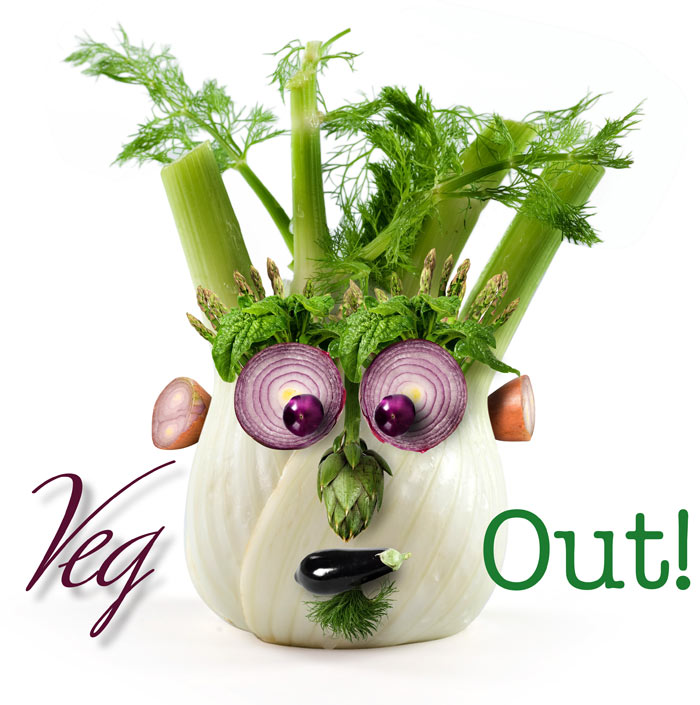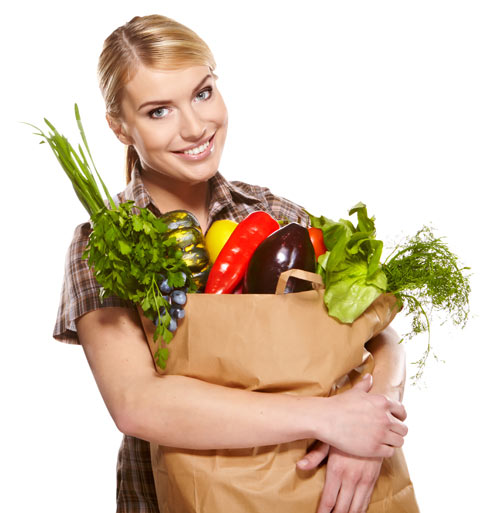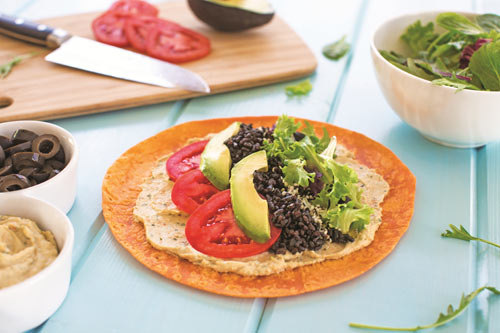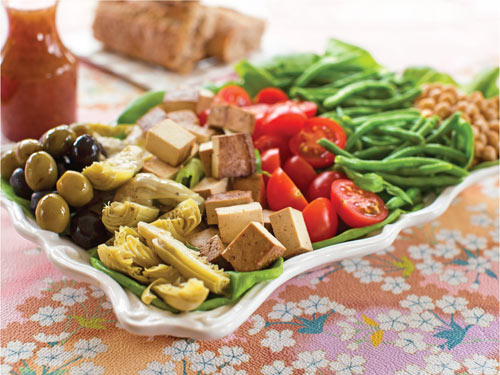
Go ahead. Toss the candy bar, join a yoga class or take a relaxing walk. Take advantage of the new year by committing to new, healthier habits. And if a healthier diet is on your menu for this year, you might want to ditch the red meat and revamp with greens. Why? Well, vegetarians are linked to awesome health benefits, like having a lower risk of heart disease and lower risk of certain cancers.
Switching your diet around can be a little tricky, but with some expert advice from Torey Jones Armul, MS, RDN, CSSD, an established registered dietitian nutritionist and the national spokesperson for the Academy of Nutrition and Dietetics, you’ll be on your way to healthier eating.
Americans are starting to consider the positive effects that come along with a vegetarian diet. About 5 percent of the U.S. population is estimated to have adapted to a vegetarian diet, and the trend seems to be steadily growing, according to a recent poll conducted by the Vegetarian Resource Group. So what’s all the hype?
“Vegetarians appear to have lower body mass index, lower LDL cholesterol levels and lower rates of hypertension and diabetes than non-vegetarians,” Armul explains. “Vegetarian diets also tend to be healthier overall, especially lower in saturated fat and cholesterol and higher in fiber and other vitamins and minerals.”
Not All Vegetarians Are Created Equal…
At first glance, becoming a vegetarian might seem simple—just don’t eat meat, right? Not exactly. There are several types of vegetarians, from flexitarians to vegans, and each has its own set of dietary restrictions.
Lacto-ovo vegetarians don’t eat meat, fish or fowl. However, they do consume dairy and egg products. The ovo vegetarian doesn’t eat meat, fish, fowl or dairy, but they do eat egg products. And you guessed it, the lacto vegetarian does eat dairy—just no meat, fish, fowl or eggs.
Becoming a vegan is a complete lifestyle overhaul. Vegans cut out all animal products—including milk, eggs and even honey. In addition, many vegans carry out their strict animal product policy beyond the kitchen, avoiding products such as silk, wool or leather.
If you’re having a hard time committing to an entirely meatless diet, there are other alternatives that may seem more feasible for your lifestyle. Simply cutting back on animal proteins, especially red meat, and reducing the portions can have positive effects on weight loss and your health, according to Armul.
“Try selecting certain days of the week, like Meatless Mondays, to stick to plant-based eating,” Armul says. “And consider a ‘flexitarian’ (flexible vegetarian) lifestyle to benefit from the vegetarian lifestyle without completely eliminating meat.”
Flexitarian diets give a little wiggle room in terms of meat, but remember that the point is to try to eliminate as much saturated fat and add more green for fiber, vitamins and minerals. This is a good route to take if you want to slowly ease into a stricter vegetarian diet or you’re just testing the waters.

Supplement, Supplement, Supplement!
So now that you know the different types of vegetarians, you should note that not all vegetarian diets are considered healthy. Just because you have eliminated some or all animal products from your diet doesn’t mean it’s necessarily nutritious. The majority of your new diet must encompass healthy plant-based ingredients that can replace the nutrients found in meat.
“People should know that adopting a vegetarian lifestyle is not automatically a healthy lifestyle. After all, white bread, cheese pizza, chips and candy are all vegetarian,” Armul says.
Supplementing is the key to having a successful vegetarian diet. When you fail to make up for the nutrients you would normally gain from eating meat, you end up with nutritional deficiencies.
People considering vegetarianism should add more fruits and vegetables, whole grains, beans, nuts and healthy fats to their meals to maintain a healthy diet.
Armul suggests incorporating alternative sources of plant-based protein such as beans, nuts, lentils, peanut butter, tofu, soy, quinoa and edamame. Lacto-ovos should incorporate skim milk, Greek yogurt, cottage cheese and eggs for protein.
When you eliminate meat from your diet, you’re also eliminating a significant source of iron. Armul suggests pairing plant-based iron sources like beans, nuts, spinach and fortified grains with vitamin C-rich foods like bell peppers, broccoli and citrus fruits. The vitamin C-rich foods will help improve the body’s absorption of the plant-based iron
To replace the Omega-3 fatty acids, incorporate flaxseed, walnuts, soy or even a daily DHA supplement. Zinc is available from soy, beans, nuts and grains. For vitamin B12, add dairy, eggs and fortified cereals.
“The biggest red flags for nutritional deficiencies are weakness, fatigue, joint pain and undesirable changes in hair, skin and nails,” according to Armul. “Other deficiencies manifest via poor cognitive and immune functioning, anemia and poor body temperature regulation.”
An annual physical exam with blood work may help catch some of these symptoms. People experiencing physical or mental changes should talk to their doctors immediately.
Bye, Bye Bacon!
Going from bacon and steak to an all-veggie diet might seem out of the question, but there are a couple tips and tricks that might make it a little easier. Here are some ideas from the Mayo Clinic to help you get started:
Ease into it. Slowly increase the number of meatless meals you eat each week. Increase the number of meatless meals you already enjoy. Love minestrone soup or vegetable stir fry? Incorporate it more!
Substitute. Many recipes can taste just as good without meat. Research it. There are plenty of websites, blogs and cookbooks with delicious vegetarian ideas. The more variety you add into your diet, the more likely you’ll meet your nutritional needs.
Need a little veg-spiration to get you going? Check out these two nutritious and delicious recipes from food blogger and writer, Nava Atlas, from her book PLANT POWER.
Hummus Wraps with Grains and Greens
Per Wrap: Calories: 400 | Total fat: 13g | Protein: 15g | Carbohydrates: 65g | Fiber: 13g | Sodium: 500mg

Makes 2 wraps
Two 10-inch wraps, at room temperature
1/2 to 3/4 cup hummus, homemade or store-bought, or as needed
2 tablespoons hemp seeds or 1 tablespoon sesame seeds (optional)
1/2 cup or so cooked quinoa, brown rice or black rice
A big handful or two of mixed baby greens, shredded lettuce, baby arugula or baby spinach
1 medium ripe fresh tomato, thinly sliced
1/2 medium, firm, ripe avocado, peeled and sliced
Strips of sun-dried tomato, as desired, (optional)
Place one wrap on a plate. Spread with about 1/4 cup hummus, and sprinkle with hemp seeds, if desired. Arrange half the quinoa down the center of the wrap. Put a big handful of leafy greens next to it on one side and half the tomato slices on the other. Sprinkle half the avocado strips here and there, followed by a few strips of sun-dried tomatoes, if desired. Tuck two ends over the fillings; then, starting from one end, roll tightly, making sure that the ends are kept tucked in and that everything remains snugly inside. Repeat with the second wrap. Cut each wrap in half and eat out of hand.
Vegan Niçoise-Style Salad
Per Serving Without Dressing: Calories: 233 | Total fat: 8g | Protein: 17g | Carbohydrates: 26g Fiber: 9g | Sodium: 655mg

Serves 4 to 6
8 to 10 ounces fresh slender green beans, trimmed
1 large head Boston or Bibb lettuce, torn, or mixed baby greens
Sliced fresh basil or chopped fresh parsley to taste
One 8-ounce package baked tofu, diced, 1 recipe homemade baked tofu or 8 ounces combined baked tofu and dense herbed tofu
One 15-to 16-ounce can cannellini or chickpeas, drained and rinsed
1 heaping cup whole fresh grape or cherry tomatoes or diced ripe fresh tomatoes
Pitted green or black olives, or a combination, to taste
Marinated artichoke hearts to taste (optional)
Sliced red onion to taste (optional)
Vinaigrette, homemade or prepared, to taste
Steam the green beans just until bright green and tender-crisp. Err on the side of undercooking rather than overcooking. Drain and rinse with cool water until they’re at room temperature. On a large serving platter or large shallow serving bowl, arrange the lettuce or greens. Scatter the basil or parsley over it. Arrange the green beans, tofu, tomatoes, beans, olives and artichoke hearts, if desired, in separate mounds over the lettuce or greens. Top everything with a few thinly sliced rings of red onion if you like. Drizzle a little vinaigrette over the salad; then serve.
For more recipes, visit her website at VegKitchen.com or look for her newest cookbook PLANT POWER: Transform Your Kitchen, Plate, and Life With More Than 150 Fresh and Flavorful Vegan Recipe.
Sources: Mayoclinic.com, vrg.org, VegKitchen.com






